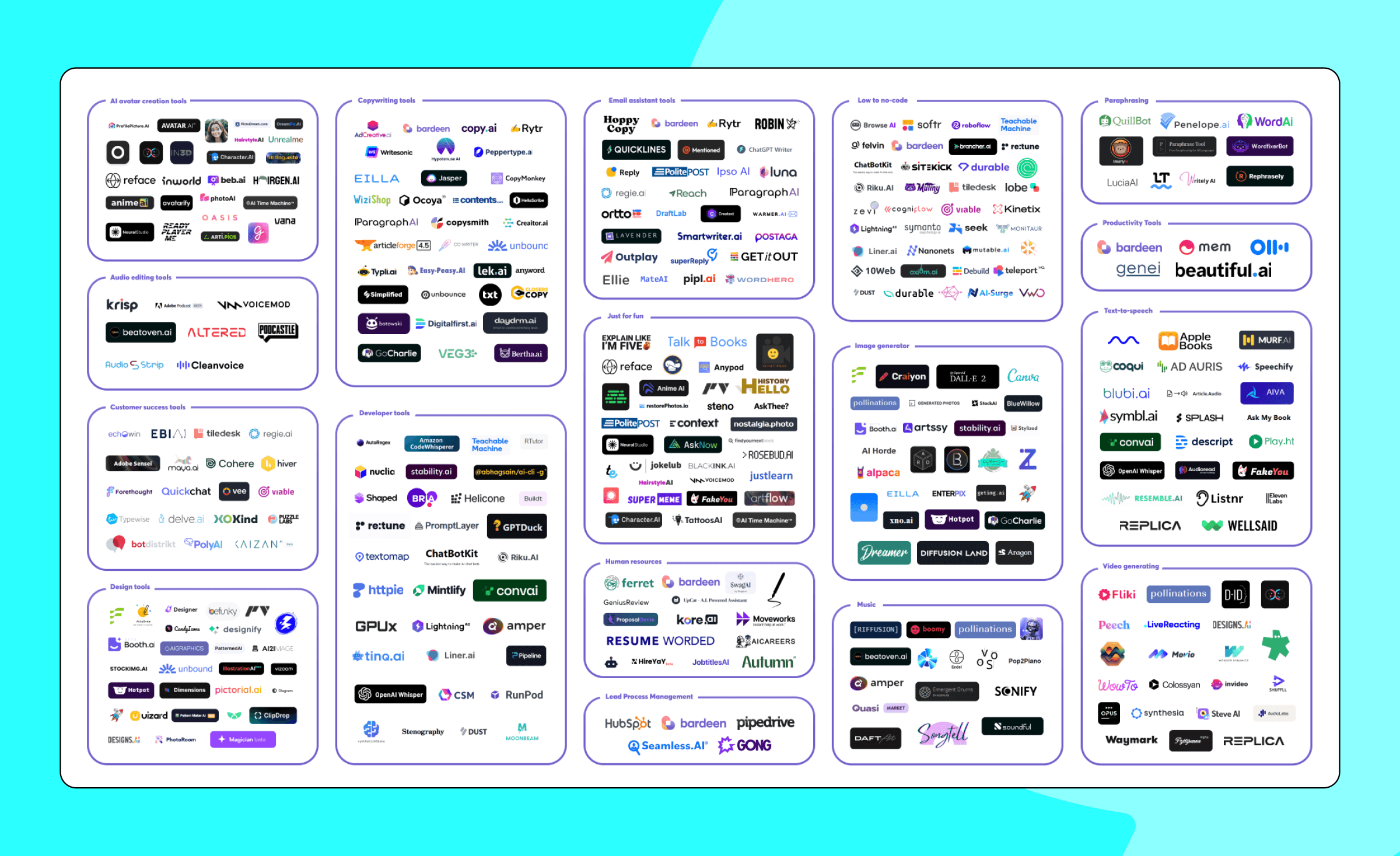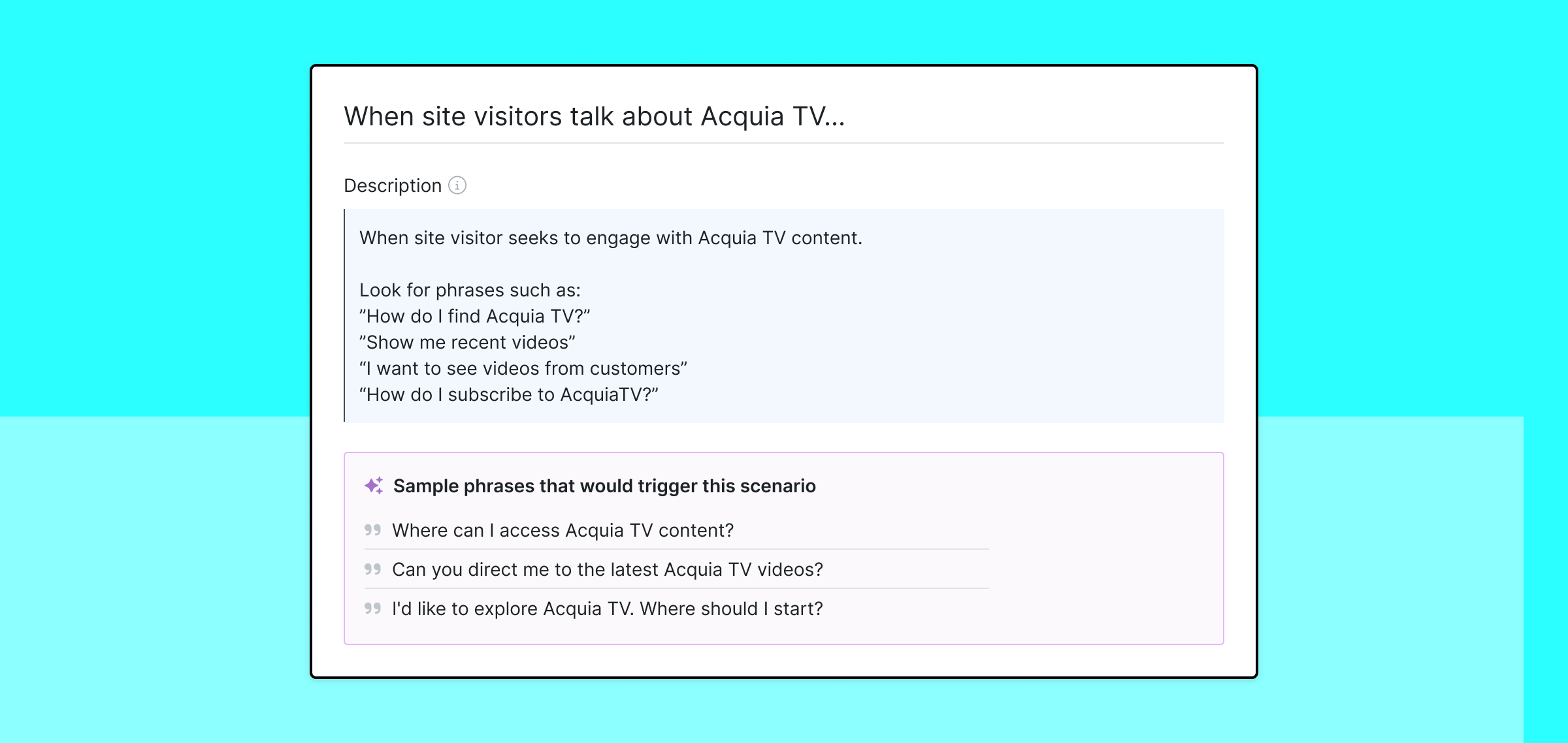Did you know that last year, an estimated one in four dollars invested in American startups went to AI-related companies, nearly double the amount from 2022? Or that the IDC predicts the AI software market will grow at a compound annual growth rate of 31.4% between now and 2027? Or have you seen a diagram like this 👇 that shows the countless tools that currently make up the AI landscape?

(Source: Bardeen.AI)
All of this points to the undeniable fact that, in the past year, the amount of AI offerings on the market has exploded. And we can be confident that the AI market will only continue to grow from this point forward.
Yet, as the Martech Big Bang of the 2010s has proven, just because there’s a lot of AI doesn’t mean it’s all created equal. Every AI solution is created for a specific purpose and leverages different types of AI to achieve that purpose. So, to make the right choices for your business, it’s crucial that you understand the nuances of each AI solution.
Hi, I’m Bernard Kiyanda, Vice President of Engineering at Drift, a Salesloft company. I’ve spent the past four years building Drift’s AI products, and while I live and breathe AI in my day-to-day, I know that not everyone does. That’s why I’m writing this blog — to help you understand how Drift fits into the modern AI marketing landscape.
Let’s dive in ⚡
The 3 Most Common Components of an AI Solution
Before getting into the specifics of Drift, let’s go over the standard architecture of AI products as they exist today.
Generally speaking, there are three types of AI most commonly found in AI marketing products: machine learning, natural language processing (NLP), and generative AI. Each field of AI can be used separately or in conjunction with each other. It all depends on that product’s use case.
For example, machine learning is most commonly used in analytics — identifying patterns in large datasets, making predictions based on historical data, and adapting to new data over time. Meanwhile, NLP enables AI solutions to interact with humans through a conversation, whether that’s helping the AI understand the context and sentiment behind a person’s words or generating responses that sound like a human. Finally, generative AI, as the name suggests, is used to generate new content — whether it’s text, images, or code — based on the data it has been trained on.
If you’re looking for a tool to accomplish just one task — say, writing email copy or consolidating data — then choosing a product that only uses one field of AI makes sense. That’s because these products focus largely on producing a certain output. But, if you’re looking for a solution to help you produce better outcomes, such as a shortened sales cycle or a streamlined buying experience for your customers, you’ll need to look for a product that leverages multiple fields of AI.
The Power of 3: Drift’s Conversational AI Solution
In the early innings of Drift’s Conversational AI solution, we leveraged machine learning and NLP in our bots to understand site visitor intent and respond to open-text questions. While this proved effective, by adding generative AI into the mix, we’ve revolutionized what conversational website experiences mean to site visitors. Now, Drift’s AI allows you to automate most of your website visitor’s buying journey, deliver streamlined, humanlike experiences, and gather important insights on the backend that help improve your overall marketing and sales processes.
There are three key reasons why we believe the trifecta of machine learning, NLP, and generative AI is the most impactful form of AI for go-to-market (GTM) teams:
1. Understand Buyer Intent for More Humanlike Experiences
Many AI chat solutions can be programmed to answer questions — but only if that question is asked in just the right way and in just the right order. By leveraging machine learning and NLP together, Drift’s AI system can not only recognize patterns within conversational data but also understand and leverage those patterns to respond to website visitors in real time. This means that, unlike AI bots that only retrieve information and spit out a prepared answer, Drift can understand why the site visitor is asking the question and provide the next best action based on that intent.

This deep level of understanding means that Drift’s AI is better equipped to assist the nearly 70% of buyers who prefer to self-serve the majority of their buying experience. For example, one of our newest products, Site Concierge, recommends content to website visitors based on their previous website behavior. So, say someone has recently looked at a company’s AI product web page; the next time they land on the website, Site Concierge may recommend a case study about a customer who is currently leveraging that AI product. Because machine learning helps the AI recognize the site visitor’s behavior, Site Concierge is able to then serve up relevant content and add context to the recommendation — all without the site visitor ever chatting with the bot.
Not to mention that, on the backend, marketers and sellers can see a consolidated view of all their site visitors’ website interactions, which allows them to better understand how visitors are interacting with their content. In fact, we leveraged our own AI Topics feature to look into and identify common themes across the 3M+ conversations that happened in Drift in 2023, which helped us reduce the time to complete a project from hours into a matter of minutes. You can see the results of that research in our Conversation Trends Report.
2. Create Experiences as Dynamic as Your Customers
Human behavior is dynamic, and we believe that website experiences should be able to cater to humans’ ever-changing needs. The only way for that to be possible is to leverage machine learning, NLP, and generative AI together.
Because while machine learning and NLP empower a chatbot to respond to open-text questions, they still pigeonhole site visitors down one conversation path. When you add generative AI to chatbots, however, you allow for more flexibility in that conversation. Drift’s Bionic Chatbots combine these three types of AI to adapt on the fly and generate the right, most relevant response for the site visitor every time. So, if a site visitor changes their mind mid-conversation or asks a question outside that conversation path, they don’t need to exit the chat and start all over.
Not only do Bionic Chatbots offer a better experience for the buyer, but they also make GTM teams more streamlined and efficient. Bionic Chatbots do this by deflecting support queries away from the sales team and making sure that only the most qualified buyers are being routed to book a meeting.
3. Always Be Learning
Practice makes perfect. But even then, perfect can be hard to achieve if you’re not also constantly evolving.
That’s why we believe it’s important for Drift’s AI to be continuously learning and adapting to feedback — and that’s exactly what machine learning, NLP, and generative AI help it to do. Bionic Chatbots, for example, constantly leverage machine learning and NLP to adapt to new trends that emerge in conversations as well as any new requirements set by the GTM team that may impact sales and support routing. This ensures the chatbot’s responses, recommendations, and calls to action are always the most up-to-date.
Additionally, on the backend, Drift’s Topic Discovery feature combines machine learning and NLP to predict emerging topics based on the current conversations happening on the website. Plus, with generative AI summarizing these topics, businesses can quickly gain a comprehensive understanding of the trends they need to be paying attention to, so they can adapt their products and strategies accordingly.
Final Thoughts
Not all AI is created equal…nor should it be. Because, just like the various marketing products we’ve known for years, each AI solution is created for a specific reason. That’s why, in turn, you need to understand your reason for adopting AI to decide which solution is right for you.
Whether you’re looking for an AI-powered chatbot, content generation tool, or analytics platform, the key to any successful AI adoption is to first build an AI blueprint. Think about the scope of work you hope to achieve with AI, where you can see it fitting into your existing processes, and if you’re looking for a quick output or an enduring outcome. Because by taking the time to understand the nuances of AI (you’ve already got a great start by reading this blog!) and what makes a product successful, you’ll be better equipped to make the right AI decision for your business.








